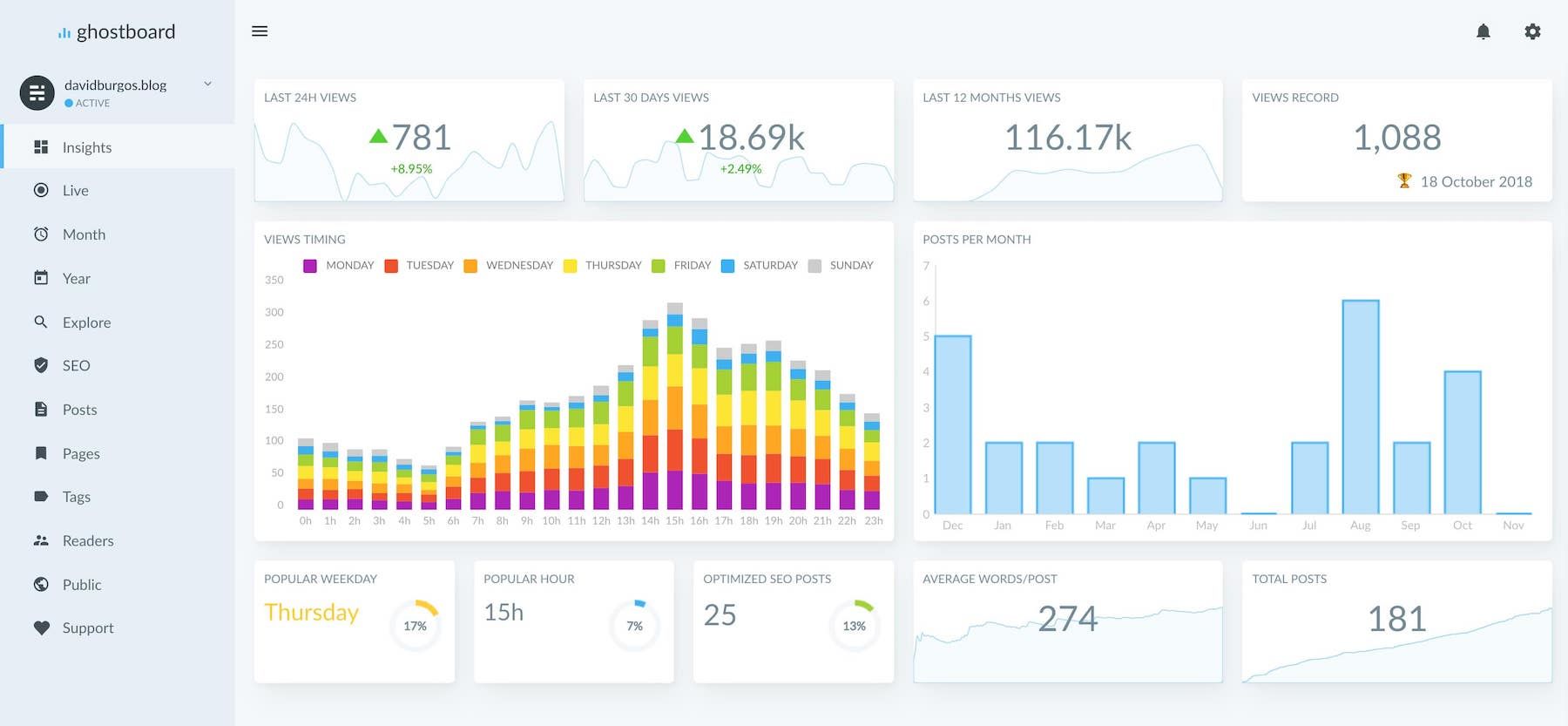Summary: I really liked using Ghostboard for its aesthetics and interface, and wish I had that available. But decided not to pay the $9 a month to keep using it past the trial, and opted to keep just using Google Analytics (GA) and in the future, a self-hosted analytics platform. I may review that decision in the future, if I build more blogs and get more page-views. Read on to find out why I made my decision in more detail.
Also read: The first 5 things you should modify in Casper, Ghost's default theme.

Background: Why an analytics dashboard for Ghost?
Since Ghost was first launched years ago, they've been talking about an analytics dashboard. It was part of the original pitch for Ghost. Nonetheless, the Ghost team, despite all the amazing things they've built, haven't yet released an in-house analytics dashboard. In the meantime, the closest thing to ghost-specific analytics is Ghostboard.
(If you're thinking of giving Ghost a try, you can sign up for a two-week free trial here. Yes, I get a referral bonus; consider it a friendly high-five of thanks.)
The idea for in-platform analytics is similar to Jetpack within WordPress: showing stats for your blog without having to resort to third party analytics, like Google Analytics. Since Ghostboard is not an integral part of Ghost, it does need you to go to a third party site to use it.
How Ghostboard Works
Most analytics dashboards (Ghostboard or otherwise) work in the same way: Javascript.
A small script is loaded in the user's browser every time they connect do your blog. Unless their browser blocks scripts, this is then run on their computer and reports information to the analytics system.
This script leaves a cookie there (so it can track repeat visitors). The script collects information about the user (location, browser type, hardware) and what they do (session time, what pages viewed, how they interacted with each page). Depending on the sophistication of the analytics engine, it might send basic info, or advanced, deep demographic info, like Google Analytics does.
All of this information is sent back to the analytics server, which displays it for you in an intelligent way, and lets you query it via a visual interface.
What I like about Ghostboard
There was a lot to like about it. The creator has done a really nice job — it's a wonderful app to use.
If it were cheaper, or if I had more blogs (or if I monetised them), I might consider using it beyond the trial period.
As it stands, I discontinued using it after the first two weeks.
What I like about Ghostboard include
- Ghostboard shows me more visitors than Google Analytics does (about 50% more pageviews). GA is great, but it doesn't work with people who use Adblock, which blocks GA by default. Since I blog about technical things quite often, this means I don't see a lot of traffic from people with ad blockers (readers of technical topics tend to have ad-blockers).

- Ghostboard has "just enough" information. Google Analytics is a huge treasure trove of data, most of which I haven't explored because I don't need to, and haven't set up the various integrations. Ghostboard shows me what I most want - how many views, which posts, what time of day - and doesn't drown me in data.
- Privacy focus (whether intentional or not). Because Ghostboard doesn't collect so much information, it preserves the privacy of users. This isn't explicit, like it doesn't claim to anonymise IP addresses (which Google Analytics can do, actually)
- Ghostboard has a beautiful, responsive interface. The interface for GA isn't bad - it has improved a lot over recent years. But it often needs to pause and load information. Also, because of its complexity, there's a lot of poking around to do before I find exactly what I need. Ghostboard, by contrast, is fast and easy to use. I really like the dark mode in particular. It's spot on, just like dark mode in Ghost proper!
Basically, while Google Analytics can be likened to full-fledged desktop Photoshop, Ghostboard is like the version of Photoshop on my phone. Much more limited, but gets everything I need done. In the world of web analytics, it's enough for me for now.

What I didn't like about Ghostboard

Still, there are reasons why I didn't sign up past the trial window.
- The price. I don't want to pay anything for analytics. It's not just Google Analytics that's free; Matomo is also free (and very privacy forward). I would pay for it if it were delivering ten times the value, like helping me home in on valuable posts that deliver affiliate or advertising income. I'm not there yet with my 20k monthly views (July 2019; but it grows by 30% a month), and even if I were, Google Analytics or Matomo (free if self hosted) would be fine. In a nutshell, I pay any money just for something that's "nice" that doesn't make my life easier or more valuable.
- Google Analytics ultimately delivers more information. Because it's Google, and Google spies on everything, you can get very rich information about the demographics of your audience. (Of course, it'll only be two thirds of your audience, because so much of it blocks GA.)
- It's a third party service that holds my data. I'd rather hold on to the data myself. Yes, I trust Google with the data, but they give me a lot back for it. My next move is likely self-hosted Matomo.
My hopes for the future of Ghostboard
The developers of Ghostboard are responsive and engaged in the Ghost community, and are nice people. I'm not sure what the future will bring, but I'm optimistic!
What I hope for in the future from Ghostboard is a few things:
- That Ghost integrates some or all of Ghostboard's features into Ghost's interface. Jetpack's main value add was that it was right there in the admin dashboard.
- No scripts: I'd also prefer for Ghostboard to run using a pixel, not JavaScript, so it's not automatically blocked by script or ad blockers (once they catch on).
- Open source, self-hosted: This is a big ask, but I'd love to serve it from my own server. The reasons for this are twofold (not even it being "free" — I'd be more likely to pay for it this way!): 1. Controlling my own data and 2. Limiting cross-domain requests. The latter always slow down a website (even if marginally), and risk being blocked by ad blockers.

